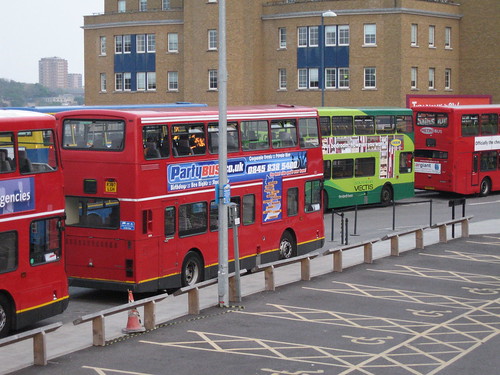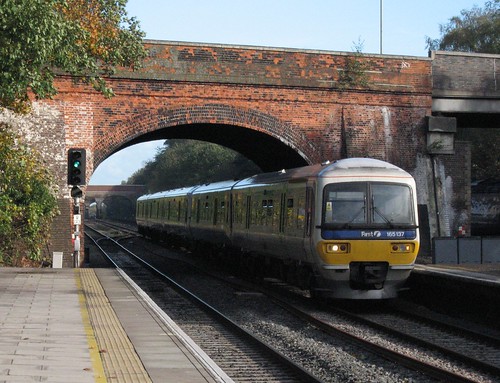Yet again at the weekends, buses are replacing trains on the 20 mile stretch of the Brighton main line south of Three Bridges, disrupting services between Brighton, Eastbourne and along the south coast.
Being a very busy route, about 15 weekends a year work has to be done on the line to make good all the wear and tear it gets. The bus services are well organised and all is as good as could be in the circumstances.
However, there must be a significant economic loss to Brighton and other places on the coast, due to the fewer number of visitors. And one wonders if it really necessary to close the entire stretch of line so often.
The real issue, however, is this. The Brighton main line has four tracks from London to Three Bridges. Just before the Second World War, when the line had been electrified, the extra pair of tracks was extended southwards as far as Balcombe Tunnel, And there it stopped, apart from a four track section through Haywards Heath. If the four tracking was completed as far as Wivelsfield, where the Eastbourne and Brighton lines split, there would be no need for these buses and it would be easier to deal with other disruptions.
This would of course be a relatively expensive stretch of line, with the construction of a second tunnel at Balcombe a new viaduct across the Ouse Valley, but how do the costs and benefits weigh up?
17 Jan 2011
Buses replace trains
5 Jan 2011
30 Dec 2010
What a difference fifty years makes
The end of the year, especially one ending in zero, is a time to look back. Here is London St Pancras in 1960. Who, when the picture was taken, would have imagined that fifty years later it would have been possible to catch a train from the same place, that would get them to Paris in three hours? Yet only few years ago, carriages of the same design as those in the train on the left were still in front line service.
Change happens in ways that we cannot expect, but long-lived pieces of capital equipment like trains, on the drawing board today, are likely to be still in use in 2070. What will the world be like in 2070? No-one can know. We can be certain that it will be very different. Energy will be relatively much more expensive. Fewer people will be able to afford cars and air travel, which means that the railways will not have to compete with the alternatives in the same way. Probably too, the train operators of fifty years' time will have to work hard just to offer a service that most people can afford.
In the next five decades, we can expect two or three cycles of boom-and-bust, major changes in technology, which stand as much chance of being lower-tech than higher-tech, demographic shifts, with associated changes in patterns of settlement and land use, and a high probability of significant natural or man-made events, the effects of which will could stretch countries and communities to the limit, and possibly beyond.
To this mix must be added in the chronic uncertainty over investment plans that can be cancelled, reinstated, amended, and cancelled again several times before any works actually start.
What kind of rolling stock is suitable for an environment so permeated by uncertainties? I hope someone is asking the question.
27 Dec 2010
It is about priorities
"How often do you go to London?"
"About four times a year"
"What is your most common journey?"
"From Long Eaton into Derby"
"How often do you make it?"
"Several times a week"
"What is the service like?"
"Crap"
"So how would the high speed line help?"
It did not take him long to realise that this investment will do nothing to improve his daily travel.
I then went on to explain that the high speed line could not provide an affordable walk-on service and he would have arrange to arrive long in advance to be sure of not missing the journey he had paid for. He is then likely to spend the time drinking coffee or looking at the magazines in W H Smith. In other words, he would have been better served with a slower but affordable walk-on service.
GW electrification back-track
The vacillations over the Great Western main line electrification are a good illustration of the confusion that reigns over rail policy in Britain. In 2009, electrification of the routes to Cardiff, Bristol, Oxford and Newbury was approved by a Labour minister. Now the project has been cut back to Oxford and Newbury, which are London commuter routes. One factor is the major rebuilding of Reading station and the adjacent junction, a scheme which will continue until 2016 and restrict the amount of traffic that can use the line whilst the work is in progress. Clearly, the electrification project needs to be integrated with the developments at Reading and for this reason it may be that other routes would be better placed in the front of the queue for electrification, of which the most obvious choice is the Midland main line, but another possibility is the Chiltern route to Oxford via a new junction at Bicester. But the aim should nevertheless be to complete the electrification to Bristol and Cardiff at the same time as the Reading reconstruction.
The cut-back of the Great Western electrification project opens up a whole series of questions about rolling stock policy, that have not been helped by transport minister Hammond's announcement that there should be no further life-extension of the HST fleet.
The intention is that the Great Western suburban routes should be operated by cascaded class 319 stock dating from the 1980s, which in turn will be replaced by a new fleet. It has been suggested that the existing DMUs used on the Great Western suburban services (above), which are actually newer than the class 319s, will be deployed elsewhere. However, this is not so easy. These units, of classes 165 and 166, are 23 metres long and 2.82 metres wide, were built specifically to take advantage of the generous clearances on the Great Western routes out of London. A study by the Rail Safety and Standards Board found that the route availability of these units is very restricted, with expensive work being needed to clear other routes.
One option that seems not to have got a mention would be to convert these diesel trains into electric multiple units, but a further question that arises concerns the life expectation of the vehicles. These were the first generation of trains having bodyshells constructed of wide aluminium extrusions with welded seams, and whilst they may have a future life of two or three decades, there is apparently no means of predicting at present, and the same applies to the class 158 DMUs of the same vintage. However, the cost risk of premature failure of the body structures could be minimised by by designing the electrical equipment for recovery and recycling. Alternatively, the units could be converted into push-pull sets powered by electric locomotives, which would be the most flexible and non-committal solution of all.
The subject is discussed in an article by Paul Clifton in the January 2010 issue of Rail Professional.
22 Dec 2010
A long wait for a fast train
Compare this to, say, the alternative of upgrading and electrifying the Chiltern line to Birmingham, where the pay-back would begin as soon as the wires had reached High Wycombe, with further gains as the electrification included Bicester and Oxford, and more again when it got to Banbury. Add in a possible electrification from Basingstoke to Oxford and Banbury, and the approved electrification of the Great Western route from Paddington to Oxford, and the gains add up to a significant enhancement of the national network of electrified routes. And all of these generate returns on the investment as each stage of the project is completed.



